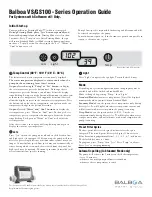
Part
No.
4801-5801
Rev.
4-2010
Page
18
of
24
Super Saver XL Heater Maywick
b
Gate
valve
Arbitrary Piping System
a
c
d
e
f
g
Heaters
Heaters
30
m
8
m
Gas meter
8
m
tees
11. Pipe Sizing Guidelines
11.1 Calculating HVR & ELOP
1.
Using a system schematic, label each piping
section of the system starting at the meter or
regulator. A different pipe section starts
where the gas demand of the system
changes, usually at a junction.
2.
Determine the Heating Value Required
(HVR) in BTUH (BTU's per hour) for each
section of pipe.
HVR = (no. heaters supplied by pipe
section) X (heat output per heater)
3.
Determine the Equivalent Length Of Pipe (ELOP)
required for sufficient gas service.
ELOP = (length from meter to most remote heater)
+ (Minor loss equivalents of the system)
IMPORTANT: Use the ELOP value from this
equation for size determination of all pipe sections.
4.
Use the ELOP value from step 3, and the HVR of
each pipe section to determine the required pipe size
for either natural gas (NG) (Table 1) or liquid propane
(LP) (Table 2) from the table 'Maximum Capacity Of
Pipe'.
11.2 Directions For Reading Pipe Size From Tables:
EXAMPLE: Four 40,000 BTUH (12 kW) heaters will be installed on the gas pipe line in the 'Arbitrary Piping System'
diagram below. NOTE: Values given in English and Metric equivalent units.
1. Determine the HVR value for each pipe section of the system.
Pipe Section
No. Of Heaters
HVR Calculation
HVR Value
BTUH
kW
BTUH
kW
a-b
4
4 x 40,000
4 x 12
160,000
48
b-c
2
2 x 40,000
2 x 12
80,000
24
c-e
1
1 x 40,000
1 x 12
40,000
12
b-d
1
1 x 40,000
1 x 12
40,000
12
b-f
1
1 x 40,000
1 x 12
40,000
12
c-g
1
1 x 40,000
1 x 12
40,000
12
2. Determine the ELOP. Length from meter to most remote heater = length from a to e (or g) = 100ft (30m) + 25ft
(8 m) = 125ft (38 m) Minor loss equivalents from Table 1 = 1 gate valve x 2ft/valve (1 m/valve) + 3 tees x 11
ft/tee (4 m/tee) =35ft (13 m). Calculated ELOP = 125ft (38 m) + 35ft (13 m) = 160 ft (51 m) Tabulated ELOP =
200ft (60 m) Round up to the nearest table value.
3. In the appropriate table, NG (Table 2) or LP (Table 3),
select the column showing the ELOP or the next longer
length, if the table does not give the exact length. Use
this column to compare table values to the HVR values.
Use the Natural Gas table (Table 2) in this example.
From step 2,
ELOP = 200ft (60 m) Locate the column labeled 200ft
(60 m) in Table 2.
4.
Select a pipe section and read down the ELOP column to
find the maximum gas capacity that matches the HVR for
that particular pipe section. If the exact value is not
listed, choose the next larger value in the column. In this
example, start with pipe section c-e. For pipe section c-
e, HVR = 40,000 BTUH (12 kW). From Table 2, column
200 ft, 40 (12) is not listed (NOTE: The table values are
in thousands of BTUH's). The next larger value of 72
(21) is read from the table, corresponding to 72,000
BTUH (21 kW).
5. Follow the row leftward until you reach the columns
labeled 'Internal Diameter' and 'Nominal pipe size'. Read
the pipe size for the particular pipe section. For example,
for pipe section c-e, the pipe size is ¾ inch (0.824 in.)
(19.1 mm). Repeat for each pipe section.







































